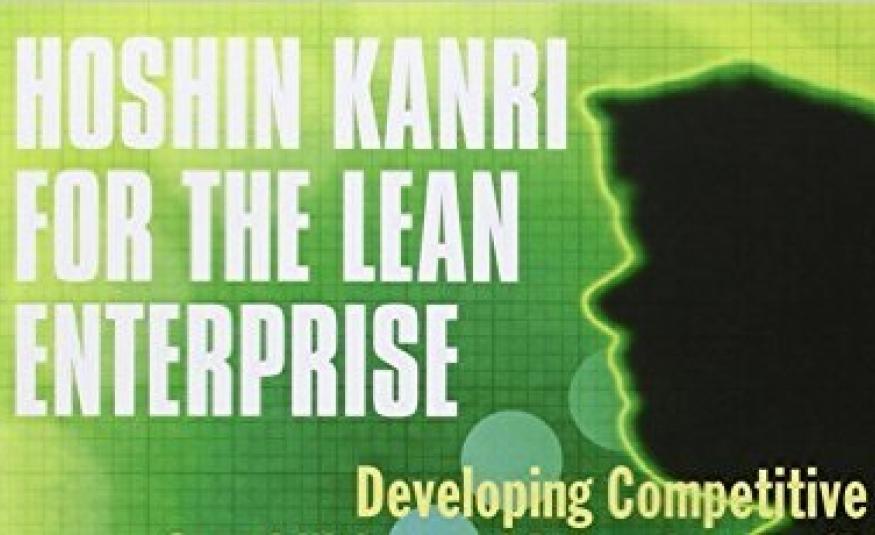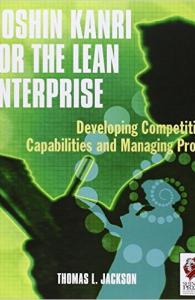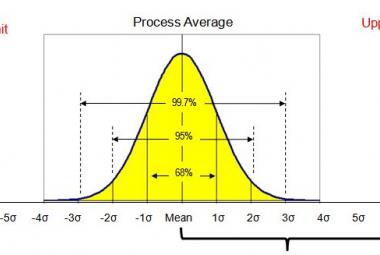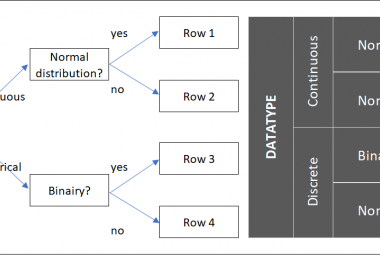In his book Hoshin Kanri for the lean enterprise, Thomas Jackson describes Toyota´s model for Policy deployment: hoshin kanri. The hoshin kanri process consists of 7 experiments, which include all employees of an organization in the problem solving process which helps the organization as a whole to reach its targets.
The tool that supports the hoshin process, and therefore plays a vital role in this book, is the X-matrix, which is used for defining the organizational targets and the breakdown of targets to each department. The cascading of targets is not a top-down activity, but an interactive catch ball process which is documented on A3-T documents. Next to that, Jackson describes 3 models to train the organization to continuously improve their own processes and 2 lean principles to motivate teams to contribute to this process.
The first experiment in the hoshin process is DEFINING THE LONG TERM STRATEGY. Jackson describes - among others - the following two models which can help you define your strategy for the next 5 to 100 years.
Porter´s Matrix visualizes how your organization differentiates itself from its competitors by mapping both your organization and the competition on two axes: product differentiation and competitive scope.
A value stream profit and loss statement shows you an overview of the financial health of every value stream. The profit a value stream makes is calculated based on the customer determines price principle. The profit of the value stream can then be calculated as: total earnings (sales) – costs. Costs can be split in three categories: development, material and conversion costs.
The experiments 2, 3 and 4 describe the DEFENITION OF THE MID-LONG TERM; THE YEARLY HOSHIN AND THE TACTICS. This is the part where the X-matrix plays a vital role. The X-matrix is shown in figure 1. In these three experiments, the first four steps of the X-matrix are filled out: strategy, results, process goals and tactics.
An example strategy for the next 3-5 years could be to use Just-In-Time principles to improve production processes.
The results that can be expected from the improvement activities could be a reduction of conversion costs of 10% which can be found on the value stream profit and loss statement.
The process goal for the next 6-18 months that derive from this goal, could be a lead time reduction of 50% for the value stream in question.
The tactic that can be used to achieve this goal could be value stream mapping, which is the overall approach to analyze the value stream and define the kaizen events that are necessary to achieve the targets.
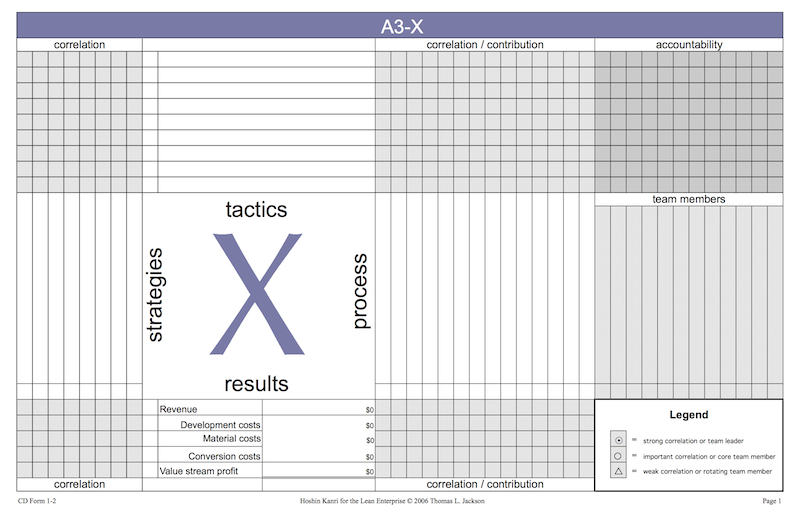
Illustration 1: An X-matrix example (Source: Jackson, 2006)
Experiment 5 describes the CATCH BALL PROCESS between the central hoshin team and the operational teams. The goal of the catch ball process is to define A3-team documents, in which a team is made responsible for implementing one or more of the tactics defined in the previous steps.
The name catch ball process refers to the catch ball we know from the sports environment. The goal for each team is to negotiate the goals with the management level above them (hence, throw the ball back and forth) and therefore agreeing on the targets before they are made official.
Experiment number 6 includes the realization of KAIKAKU IMPROVEMENTS. These are the improvement projects defined for the following week up to 2 months, as part of the tactics defined in earlier experiments. In this chapter, Jackson describes the following three training methods as most valuable to improve an organization:
An apprenticeship in which the student is coached by a coach for a long period of time. This is by far the most effective method to create a culture of continuous improvement. This method is also the most costly, and therefore not very popular in western organizations.
The kaizen blitz (or kaizen event) is a 1-5 day event in which a team implements (part of) a tactic that leads to radical improvement. This is a classic example of learning on the job, in which the coach explains some theory on day one, while the rest of the event is used to use that theory to implement real processes.
The train the trainer principle is a method in which participants are trained to lead kaizen events and are taught how to teach others to use the PDCA improvement cycle. Put a bit differently: managers are trained to act as coaches themselves. This method is based on the TWI method, in which an individual follows the following steps:
- Participate in the train the trainer training
- Lead a kaizen blitz as team lead
- Co-train the next generation of participants of the train the trainer training
- Lead the train the trainer training
The seventh and final experiment takes place on the lowest aggregation level of the organization and is called KAIZEN. These are the small improvements which should directly contribute to respectively tactics, process goals and strategy of the X-matrix. Jackson describes visual management and the daily management structure as the two most important tools to create an environment in which problem solving is encouraged.
Visual management is combination of workplace organization (6S), visual controls (team boards, andon or kanban) and error prevention (poka yoke). All these principles help employees to recognize and correct problems real time, before these problems grown so big that they need to be tackled in huge projects (or hoshin tactics) in the future.
The daily management structure supports problem solving within all teams, but also the hoshin tactics which are cascaded down the different team boards. With a daily level 1, 2, 3 and 4 meeting, the progress of achieving the hoshin tactics of the entire value stream can be followed up on a daily basis.
Hoshin kanri for the Lean Enterprise is a clear workbook in which the need for hoshin is explained. Tools like kanban, team boards and 6S are only valuable when they are used to detect and solve problems that prevent the organization as a whole to reach its targets.
The seven experiments that Jackson describes in this book, helps you think about selecting the right tools for a certain strategy and how to measure the progress of reaching the strategy in the KPI structure.
The X-matrix is the central tool in this book, which supports the discussions within and between teams, with the goal to generate consensus on what the organizational strategy should be.
Continue to:
The Toyota Production Development System – J.M.Morgan and J.K.Liker (summary)
SOURCE:
Jackson, T.L., 2006, Hoshin Kanri for the Lean Enterprise – Developing Competitive Capabilities and Managing Profits, Boca Raton (FL, USA): CRC Press (order this book)

